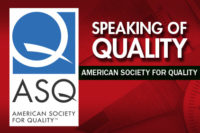Good products don’t just happen. Quality depends on processes, and a process approach outlines the steps for success. Like so many elements of quality, it requires methodical attention to detail and planning. Unlike other aspects of quality, companies of any size can benefit from it. What varies is simply how you go about using it in your work.
According to ASQ, “Process view of work is defined as the understanding that work can be viewed as a ‘process’ that has inputs, steps, and output(s) and that interfaces with other processes within an organization. It is the overall awareness of the tactics and methodologies used ‘by an organized group of related activities that work together to transform one or more kinds of input into outputs that are of value to the customer.’”
What are the benefits of this type of approach? According to “The Process Approach in ISO 9001:2015” from ISO, possible benefits to this approach include: a focus on high‐risk processes, better use of resources, as well as improved customer satisfaction and enhanced confidence in the organization. The paper explains that a process is “a set of interrelated or interacting activities that use inputs to deliver an intended result,” and goes on to note that “Inputs and outputs may be tangible (e.g. materials, components or equipment) or intangible (e.g. data, information or knowledge).” Every process has inputs and desired outputs, and the goal is to work on improvements along the way.
When lined up with the right tools, the process approach can make your organization stronger. Risk-based thinking and Plan-Do-Check-Act (PDCA) are a key part of the process approach. As the paper states, “These three concepts together form an integral part of the ISO 9001:2015 standard. Risks that may impact on objectives and results must be addressed by the management system.”
With risk-based thinking and Plan-Do-Check-Act as such useful strategies for the process approach, let’s address the concepts in more detail. Use PDCA to plan which processes to use. Risk-based thinking can help in mitigating any issues that might come up. Whenever possible, the risks should be addressed and the processes improved. The bottom line is that it is important to consider how processes are developed or how risks are evaluated. These basic concepts have been around for a long time, but still resonates today.
On the ASQ site, Jack West explains the why the process approach is still around. He explains that the emphasis on process approach as it relates to ISO 9001: 2015 is stronger than ever.
“There are those who have indicated they think the process approach is gone. That’s absolutely not the case,” West tells ASQ TV. “In fact, at the DIS level (draft international standard level), the requirements for using the process approach have been more prescriptive rather than less. So, the emphasis remains. Of course, for both new users and old hands, process mapping and the use of process management techniques is an absolutely critical aspect of having an effective and efficient system. So it’s not going away, it gets enhanced.”
With this enhanced emphasis on the process approach, there are a few ways to break down the idea. In her article for Quality, “ISO 9001:2015 Implementation: The Good, the Bad and the Trending,” Penny Ouellette of Orion Registrar notes some benefits regarding the standard. She writes, “Some clients are really pushing the notion of using a process (plan-do-check-act or other) approach to developing and improving their systems.” In other positive ISO 9001: 2015 findings, she also noted the positive “emphasis on process measures under Quality Objectives and Planning (6.2) and how to achieve them.”
If achieving this kind of process approach sounds tough or you need more motivation to work on your processes, perhaps an audit will be the push you need. In writing about today’s auditing environment for Quality, Lorri Hunt of Lorri Hunt Associates, writes “One of the requirements for management system standards is that internal audits be conducted of the processes of the management system.”
Organizations use different types of processes to conduct work, but there are only three general styles of process in any industry: management processes, business processes, and support processes.
Bring on the Tools
So, you understand the importance of processes. But how to go about improving them? As with so many things in quality, there are a range of tools:
Failure mode effects analysis (FMEA)
Perhaps you have a favorite tool and like to use flowcharting for everything. In that case, chart away. Whichever one works best for you is fine. Improvements don’t need to be done in a rigid manner. Processes aren’t meant to be constricting—they are there to ensure things run smoothly.
Now the beginning of a new year and a new decade—and New Year’s resolutions—is upon us. (And really, the end of New Year’s resolutions is likely not far behind.) Rather than making grand pronouncements and ambitious goals, we would all do well to remember that processes are often the way to get ahead.




